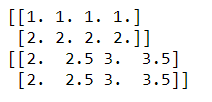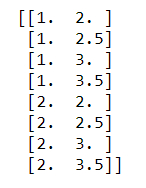Content source video, video address: here
In March 2019, the beta version of
tensorflow 2.0 was released. In October 2019, tensorflow 2.0 was officially released.
In January 2020, tensorflow 2.1 was released.
-
Create a tensor,
tf.constant(张量内容, dtype=数据类型[可选]) -
The
numpydata loaded intotensorthe data type,tf.convert_to_tensor(数据名, dtype=数据类型[可选]) -
Create an all-
0in tensortf.zeros(维度),; -
Create an all-
1in tensortf.ones(维度),; -
Create a tensor with all specified values
tf.fill(维度, 指定值),; -
Generating a normal random number, the default mean
0, standard deviation1,tf.random.normal(维度, mean=均值, stddev=标准差); -
Generate a truncated normal distribution random number
tf.random.truncated_normal(维度, mean=均值, stddev=标准差);
the value of the random number is (μ − 2 θ, μ + 2 θ) (\mu-2\theta, \mu + 2\theta)( μ−2 θ ,μ+2 θ ) , the outside will be regenerated; -
Generate uniformly distributed random numbers
tf.random.uniform(维度, minval=最小值, maxval=最大值),; -
tensorData type conversiontf.cast(张量名, dtype=数据类型):; -
The minimum value of the tensor element dimensions:
tf.reduce_min(张量名, axis=轴),axix=0indicates column,1indicates the row;
There are similar:tf.reduce_max,tf.reduce_sum,tf.reduce_meanand the like; -
tf.Variable(初始值)Mark the variable as "trainable", the marked variable will record the gradient information in the backpropagation.
eg.w = tf.Variable(tf.random.normal([2, 2], mean=0, stddev=1)), that is, the normal distribution randomly initializes the trainable parameters of our defined dimensionsw:

-
Four
tf.add(张量1, 张量2)operations:tf.subtract(张量1, 张量2),tf.multiply(张量1, 张量2), ,tf.divide(张量1, 张量2), corresponding维度相同的张量才可进行四则运算arithmetic; . -
tf.square(张量),tf.pow(张量, n次方),tf.sqrt(张量), Corresponding to the square, square root and power; -
Use
tf.matmul(矩阵1, 矩阵2)to perform matrix multiplication; -
The pairing, use
tf.data.Dataset.from_tensor_slices((输入特征, 标签)),NumpyandTensorformat of input features and corresponding tags can all use this sentence to read in data. -
The function's derivative operation on the parameters uses the
withstructure to record the calculation process togradientfind the gradient of the tensor.
with tf.GradientTape() as tape:
若干个计算过程
grad = tape.gradient(函数, 对谁求导)
Case:
with tf.GradientTape() as tape:
w = tf.Variable(tf.constant(3.0))
loss = tf.pow(w, 2)
grad = tape.gradient(loss, w)
print(grad) # 6.0
Because the objective function is y = w 2 y=w^2Y=w2. And the derivative variable of the mark isw, and initialized to a constant3, then the result is6.
- One-hot encoding means, use
tf.one_hot(带转换数据, depth=几分类),
eg.
datas = tf.constant([2, 0, 1])
classes = 3 # 待分类类别
output = tf.one_hot(datas, depth=classes)
print(output)

softmaxwhich is:tf.nn.softmax(x)- Parameter self-updating function,
tensor.assign_sub(tensor要自减的内容)
w = tf.Variable(4)
w.assign_sub(2)
print(w) # 2
Similarly, there areassign_add
- Returns the maximum subscript of the tensor on the specified axis,
tf.argmax(tensor, axis=轴)
a = tf.constant([[1, 2, 3],[4, 5, 6]])
print(tf.argmax(a, axis=0))
print(tf.argmax(a, axis=1))

- Conditional statements,
tf.where(条件语句, 真返回A, 假返回B)

- The two data are superimposed in the vertical direction,
np.vstack(数组1, 数组2)
import numpy as np
a = np.array([1, 2, 3])
b = np.array([2, 3, 4])
c = np.vstack((a, b))
print(c)

- Grid coordinate point generation,
np.mgrid[],.ravel(), np.c_[]
x, y = np.mgrid[1:3:1, 2:4:0.5] # 起始值:结束值:步长
print(x)
print(y)

x, y = np.mgrid[1:3:1, 2:4:0.5] # 起始值:结束值:步长
grid = np.c_[x.ravel(), y.ravel()]
print(grid)
